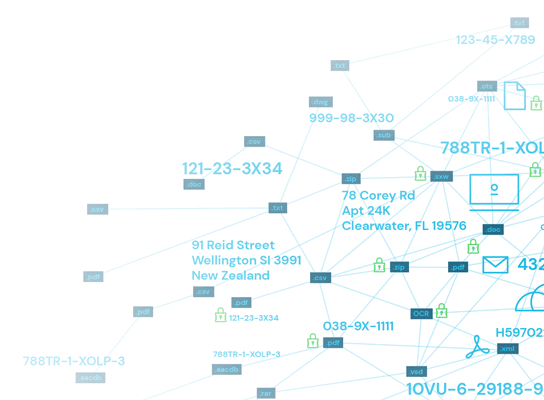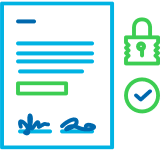
Data Classification Software Tools: Capabilities and Benefits
- What is data classification?
- Data classification challenges
- What does data classification software do?
- Key features to look for in data classification tools
- What are the benefits of data classification software?
- How is data discovery crucial to data classification?
- Key questions to ask when choosing a data classification software
- Improve data classification with Spirion’s Sensitive Data Platform
Does your organization struggle with data security and compliance? Many companies find protecting customer data and remaining compliant with data privacy regulations to be one of their biggest challenges.
Data classification tools can help you categorize your data, safeguard it appropriately, and reduce the amount of data you have to protect by eliminating redundancies and segmenting datasets to account for risk, sensitivity, and vulnerability.
What is data classification?
Data classification consists of separating and organizing data based on sets of clearly defined characteristics. You can use data classification software to group data together based on what compliance regulations apply to it, what level of risk the data presents and how sensitive the data is from privacy and security standpoints.
Data classification challenges
In order to properly classify data, you have to know what data your business collects, where it is within your company, and who has access to it at any given moment.
Some data may be funneled into your organization through contact forms filled out by potential customers. This could include personally identifiable information (PII) such as their name, place of employment, job title or email address. Other data may be collected at a point of sale and may include PII like their physical address, or financial data like payment information or credit card numbers.
Data can be captured and fed into your system through networks, sharing platforms, endpoints and cloud files. Large datasets may pose little to no risk due to their anonymized nature. Or, they may simply not contain data that is not considered sensitive. However, there are other datasets that can be high risk due to their in-demand status, and these can be an attractive target for hackers.
What does data classification software do?
Data classification tools can help you identify and tag all sensitive information wherever it lives across your business by creating attributes that can be assigned to each piece of data. These tags, or classifications, can be used to determine how a certain piece of data should be stored, managed, used and shared based on corporate and regulatory requirements.
When your data is easy to find and has been thoroughly categorized, you can create and apply protections, focus your security resources on vulnerabilities, reduce your data footprint (and with it data exposure), and get rid of redundancies in your data protection strategy.
Key features to look for in data classification tools
Your data classification tools should be focused on streamlining your data protection strategy for efficiency and effectiveness. With appropriate data classification and management, you can readily achieve compliance and reduce the load on your IT department at the same time.
When shopping for data classification software review its capabilities to see if it can:
Identify and apply labels to data
Your organization is responsible for creating a data classification schema, based on the types of data you collect and store and any regulatory compliance laws you are bound by. Your data classification software is responsible for scanning and identifying data, then putting this schema into action.
A commonly used schema divides data into four main classifications:
- Public: Data that is already readily available on public networks, and is not considered to be sensitive.
- Internal: Data that may be proprietary in nature, and is not intended for external viewing or consumption.
- Confidential: Data that may belong to your company or to customers, which is considered to be confidential even if it is not considered “sensitive,” and which can cause harm to your company if exposed by a breach.
- Sensitive: Data that is considered highly sensitive, may be subject to regulatory oversight, and which typically could be used to cause some form of harm to the consumer if it were made public.
Classify data in real-time
Enterprises deal with large volumes of data and have multiple data streams feeding even more data into the organization at all times. Classifying data as it enters your organization’s data landscape is best practice and can help you stay ahead of the data classification game.
Your data classification software should be capable of monitoring incoming data feeds around the clock in real-time, from on-premise to the cloud and across endpoints and devices.
Automate your data classification policies and workflows
When handling any process, human error is the most common cause of problems. This is especially true when it comes to data management—particularly with hackers who use social engineering to find and exploit vulnerabilities among employees and outside vendors.
The right data classification tool can help take manual hours and human error out of the equation. Your team can be freed up to focus on strategic decisions and planning. The software will automate the workflows and policies and apply them to your data with minimal margins for error.
What are the benefits of data classification software?
Data classification software makes the data classification process easier and more streamlined for enterprise organizations, cutting back on human input and automating as many processes in the data classification workflow as possible.
Reduced financial risk
When your IT and cybersecurity staff no longer have to worry about searching for sensitive data, categorizing it and monitoring it, they can engage in more proactive, strategic thinking. Improving data classification accuracy and reducing human error can also cut down on financial risk; the average cost of data breaches due to human error stands at $3.33 million, according to IBM’s Cost of a Data Breach Report 2020.
Minimized data breach risk
Data classification tools also help you safeguard sensitive data and reduce your sensitive data footprint. Monitoring in real-time allows you to better protect your customers’ sensitive data by catching each new dataset and point of capture into your system, classifying it and directing it to the appropriately protected area.
When you know what data your organization is storing and where it is stored at all times, as well as who accesses it and how, you can reduce risks of a data breach or data loss. Protocols and processes for accessing and using data also prevent vulnerabilities or gaps in your security from occurring and being exploited.
Increased compliance
If your data or your location puts you in a position of needing to comply with any of the many data privacy laws, your data classification software can help. Any health or financial data, or personal consumer data that may fall under the purview of such legislation can be immediately segmented and placed in an appropriately protected area.
Fines are on the rise for companies that do not comply. The EU’s General Data Protection Regulation can impose vast fines as well for companies deemed not to have appropriate secured consumer data; the GDPR allows the EU’s Data Protection Authorities to issue fines of up to €20 million ($24.1 million) or 4% of annual global turnover (whichever is higher).
From July 1st, 2020, the California Attorney-General began enforcing the California Consumer Privacy Act (CCPA), and became able to pursue a civil penalty from any person who fails to comply with the CCPA. Fines apply to a violation of any section of the CCPA, and can add up to hundreds of millions of dollars.
However, businesses showing a proactive and reasonable approach to compliance, even in case of a CCPA violation, may be able to avoid a penalty. This is where data classification tools may be of the most value, as a way to show compliance and maintain the rigid protections required.
How is data discovery crucial to data classification?
The first step to data privacy management, even ahead of data classification, is data discovery. No matter how good your data classification tool is, without excellent data discovery you’re unlikely to find all of the sensitive data across your organization to classify.
While separate search and find tools exist specifically to locate sensitive data, it makes more sense to invest in a data classification software that includes a discovery component, so your data can be swiftly and seamlessly found, classified, and protected without the need to bridge gaps between tools.
Key questions to ask when choosing a data classification software
When choosing a data classification tool, ask the following questions to help you evaluate each software option and make an informed decision.
- Does the tool support scalability?
As your organization grows, the amount of data you need to manage and store may expand exponentially. You need a data classification software solution that will scale seamlessly as you grow, and support your business long term. - Does the tool work across different data types?
Make sure that the data classification software you choose is capable of supporting all of the file types across your organization that may hold sensitive data, including PDFs, CVS, .xls, .doc and .txt files, to name only a few. Being able to classify data across all file types present in your organization is critical. - Does the tool work across multiple systems?
The where of your sensitive data storage is just as important as the amount of data or type of data being stored. You need a data classification software vendor that will work across platforms, networks, and devices, including cloud repositories, Windows / macOS, file server, USB drives, and more. - Will the tool reduce problems or create them?
Data classification is a time consuming and complex process. Your data classification software should provide multiple ways to automate processes, and give you a centralized console that allows you to easily manage your data with a birds-eye view. - What else can this data classification tool do?
After discovery and classification, does the tool also offer guidance for regulatory compliance, around the clock monitoring of incoming data, and automated implementation of your organization’s security protocols? Data classification software should do more than just serve a single purpose. Instead, it should integrate into your business and become part of your overarching data security strategy.
Improve data classification with Spirion’s Sensitive Data Platform
Are you ready to say goodbye to the frustration and concerns posed by inadequate data identification, classification, and regulatory compliance? Spirion’s SaaS solution gives you access to our Sensitive Data Platform that checks every box, from discovery to classification and beyond. To see the platform in action, watch a free demo or contact us today.
